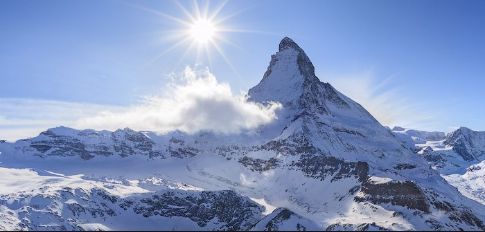Zermatt wears a happy-go-lucky, bank holiday air at the height of the summer season, but there are two places in it which bring you up with a jolt. The first is the cemetery, which is populated for the most part by those who have come to a quiet end in the valley. But among those graves are many others of people whose deathbed has been the glacier beneath the mountain. There are rough slabs of rock for local guides, with a photograph on them and a miniature ice-axe and rope cast in bronze or silver. There are more impersonal blocks of marble with nothing but an inscription… to three friends from Oxford here, to three other friends from Cambridge there, to a solitary from Hertfordshire who perished in a snowstorm on the mountain. And in one corner are three very special tombstones, to Michel Cron, to the Rev. Charles Hudson, and to Douglas Hadow, who went out with Whymper and whose rope broke on the way back. They cannot decorate Lord Francis Douglas’s grave, because he is still somewhere in the glacier.
The other place is the museum. There is a room in it devoted to the relics of the first climb. Hadow’s boot is there, the boot which may have been the cause of the accident; the sole is half torn off and it does not look as if it had ever been nailed decently. And then there is the rope that broke, perhaps ten feet of it in a neat bundle. One end has been cut, the other is a raggle of frayed strands. It is a ridiculous thing to find in a mountaineering museum, thin and hopeless. You might hang your washing on it but no man in his senses would put his life on it – much less four men’s lives – at 14,000ft.
In Zermatt this week, however, they have not cared to dwell much on fatality, and in this they have shown a proper sense of occasion. For the Matterhorn has been a tower of strength to them. So the emphasis has been on the camaraderie, the invigoration, and the smooth well-being of the mountain life. They have recruited guests of honor from all over the world to share this feeling. The streets have been shown, a memorial service has been held. There has been the first performance of an Alpine symphony, poetry has been declaimed by imported actors, films have been shown, a memorial service has been held, and the shops have been plundered of their boots by Bally, their cameras by Hasselblad, their sweaters by Hardy Amies. There have been speeches galore. There has not, though, been much climbing.
All this has sprung from that mountain which has glittered like a great jewel above the village all week, benefactor, tower of strength, trinket of incalculable value – the Matterhorn has been all these things to Zermatt. The stranger in the village finds himself lingering over the awful drama of that first ascent. He would look at it differently if he belonged here. A sensation it undoubtedly was, and it caused a lot of genuine hand wringing. But it was never a tragedy.

